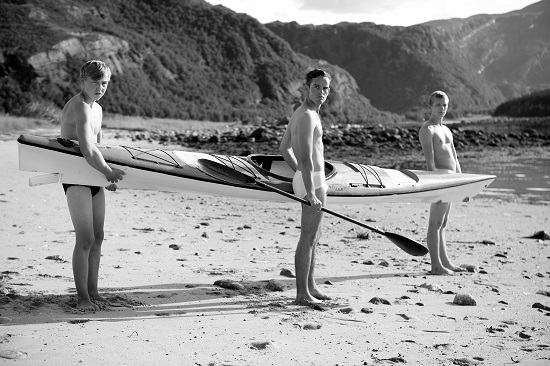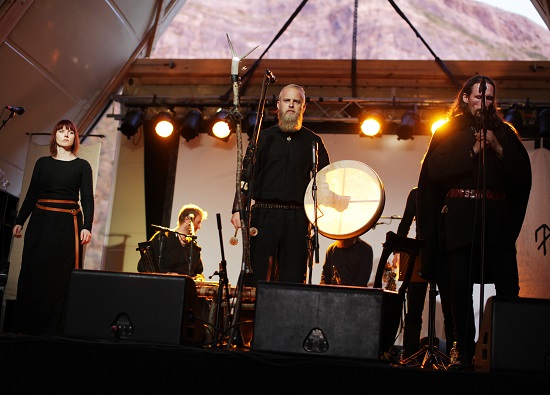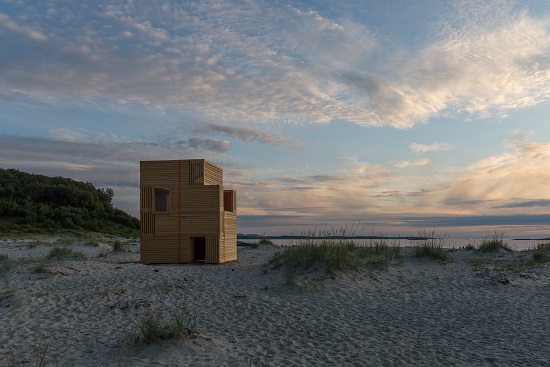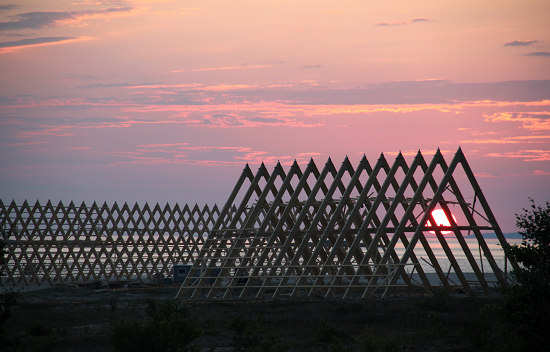SALT is a new international arts and music festival set on a remote Arctic beach on the gorgeously mountainous island of Sandhornøy in Northern Norway. The ethos behind the festival stems from the fact that the Arctic is becoming increasingly vulnerable to climate change and the exploitation of oil reserves. With Arctic nomads having lived in this landscape for tens of thousands of years, developing a close relationship to nature and taking advantage of all the natural resources available, what will happen once exploitation begins? Curator Helga-Marie Nordby’s theory is that engaging people through the staging of performances and art in a breathtaking landscape will ultimately inspire respect for the environment. Cue an eclectic selection of art and music, cleverly curated to highlight the underlying threats.
The opening night’s music programme is put together in collaboration wtih nyMusikk (Norway’s centre for new music and sound art), featuring the Arctic Symphony Orchestra, the Ensemble Ylajali (an all female choir), Lonnie Holley plus DJ Are Mokkelbost. The Ensemble Ylajali and the Arctic Symphony orchestra sit perfectly as the opening acts and stand as a complete contrast for what’s to come – Alabama born, outsider artist and musician Lonnie Holley, aka ‘The Sand Man’.
I met Lonnie earlier that day at the airport and he certainly makes quite an impression. Lanky, grey bearded and with ring-clad fingers, he whips out his sketchbook and flips to a picture he had painted the night before of an island with a rising sun over a mountain. He shows us another watercolour, this time a more interesting abstraction of mother earth and I begin to wonder about Lonnie’s folk outsider vibe, which seems totally alien to the festival’s local ethos. However, his performance that night feeds from the wild atmosphere on the beach and his bluesy, improvised songs ebb and flow effortlessly. Despite the somewhat out of place lyrics about down and out African American life in the South, his folkish, soulful music and experimental approach completely gel with the ethereal mood.
Yang Fudon is the other far flung artist on the island, from China, whose specially commissioned video work is all about embodying a sense of place. He spent a month in the area developing the correct peace of mind, wanting to capture "the emotions of the light" on the island (his piece is aptly titled The Light That I Feel). His eight different black and white films are positioned in a constellation pattern underneath a giant wooden fish rack structure. They depict teenage boys and girls (hired locally) in various stages of awakening, beginning with three awkwardly naked entwined girls and ending with a dance towards the sea. With definite references to Ingmar Bergman, his work does much to explore the magic of the place.

After contemporary Nordic 3 piece Slagr performed their wistful, resonating sounds, and singer songwriter Elle Marja Eira wowed us with her traditional reindeer herding song, Norwegian pagans Wadruna came on. This is the band we’d been waiting for, having spotted them earlier on our ferry, their lead singer, Gahl, dressed in black leathers, looking wistfully out to sea, eyes closed (for quite some time), perhaps in mental preparation for the night ahead.
On stage they are solemn and serious, in full Norse regalia – black robes and thick leather belts, long hair – pointy bearded men righteously holding staffs made out of reindeer. ‘Ward’ means ‘keeper of secrets’ and ‘runa’ rune in Old Norse, and they certainly appear to be harking back to a different time. They play a number of songs that could easily figure as the soundtrack to a period Viking drama, with Lindy Fay Hella’s Enya-esque voice crying out dramatic battle chants. It’s as if we’re about to be invaded by sea or from the mountains. Either way, one suspects that Wadruna would protect us.

The architecture of SALT is the festival’s most impressive feature and the giant structure that houses Yang Fudon’s video artwork is one of three triangular architectural installations inspired by the traditional fish rack, the other two being the stage venue and a gigantic glass fronted sauna and amphitheatre, capable of seating 120 people. There are also little ‘Njalla’ mobile tents that guests are invited to sleep in. They can be dragged along the beach until the perfect spot is found and their glass ceiling allows for cosy bedtime star gazing.
The idea is to leave as few footprints as possible, just as the nomads do. The structures are easily erected and taken down and the fish rack idea comes from the need to preserve masses amounts of fish in hellishly long winters by salting and drying them. The rack’s beams would traditionally float in the water, allowing them to travel easily from island to island. From afar the giant fish rack sits impressively on the sandy beach as if just landed, a simple structure, but up close, the design is subtly ingenious. It allows for strong gusts of wind to whisk through the sides and proves fun to climb on and to walk underneath, with the shadows of the beams fading in and out along the sand depending on the time of day. Luckily these structures don’t stink of dried fish either, which for the record, does taste good once you get past the intense smell.

So, what is the Arctic point of view according to SALT? It’s a mystical one, probably experienced only once in a lifetime by most. It’s a terrific alternative adventure and a welcome contrast to any mainstream tourist Arctic trip. This is one that considers, celebrates and protects the environment it promotes, and that connects culture back to nature. As a budding festival, SALT is totally inspired. The mix of international artists with local Norwegian music and site-specific work in such a remote place allows for a truly unique experience, and this is only the beginning. The festival will travel across the Arctic, to Greenland, Iceland, the Faroe islands, Ireland, Scotland, Spitsbergen, Alaska and Russia, all over the next 8 years, spreading the once in a lifetime experience even further afield.


